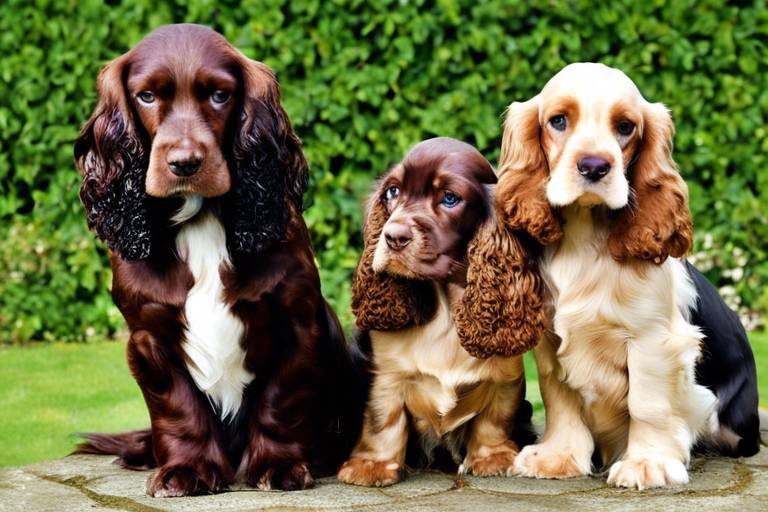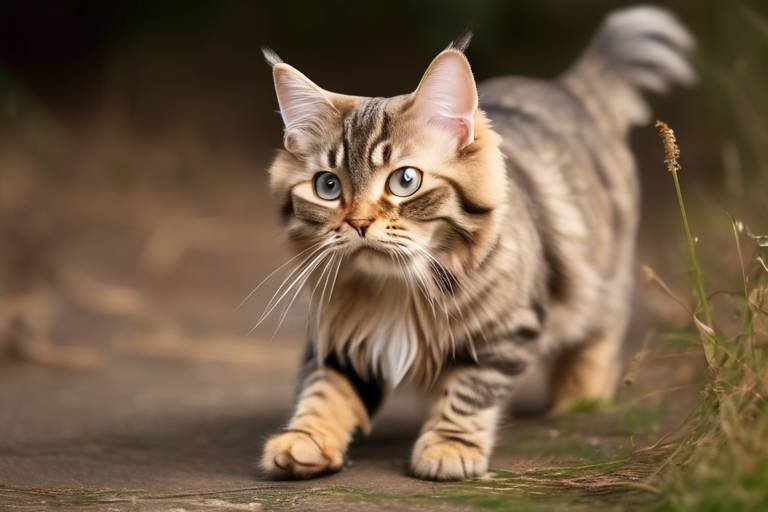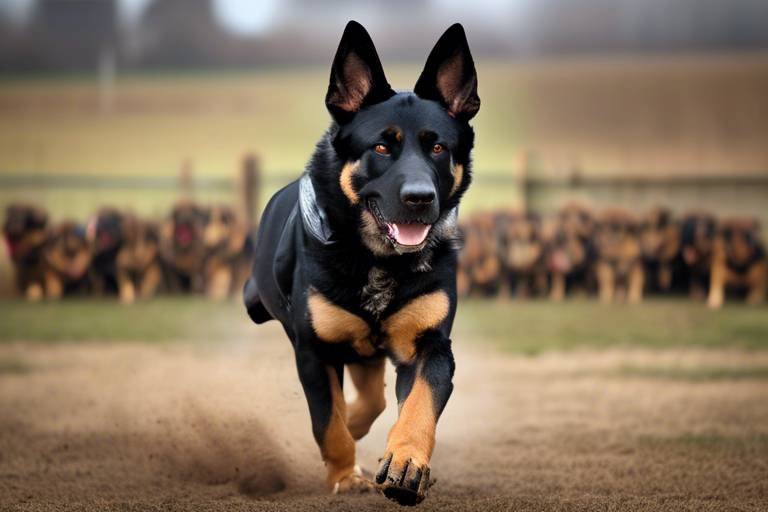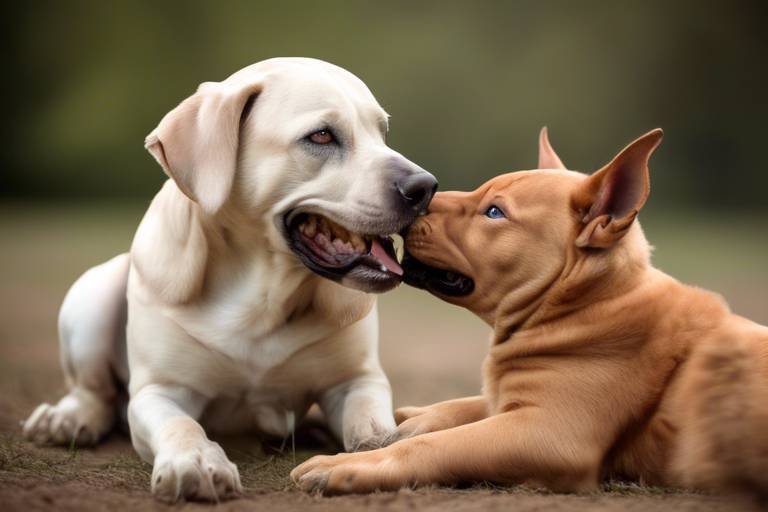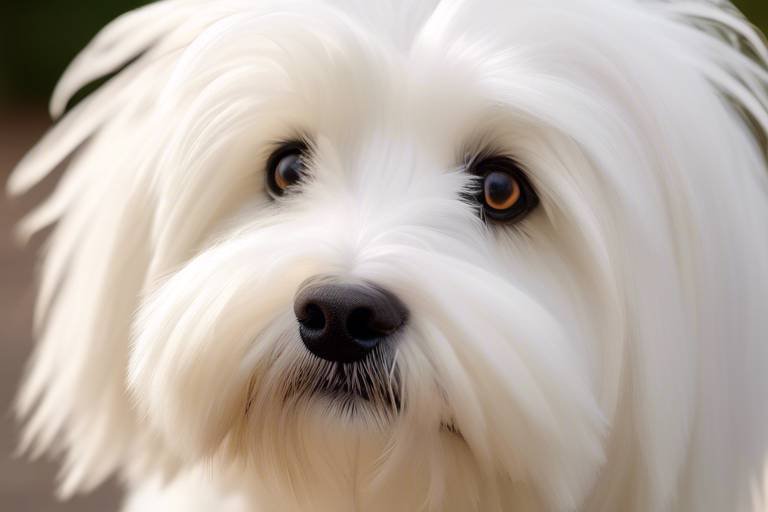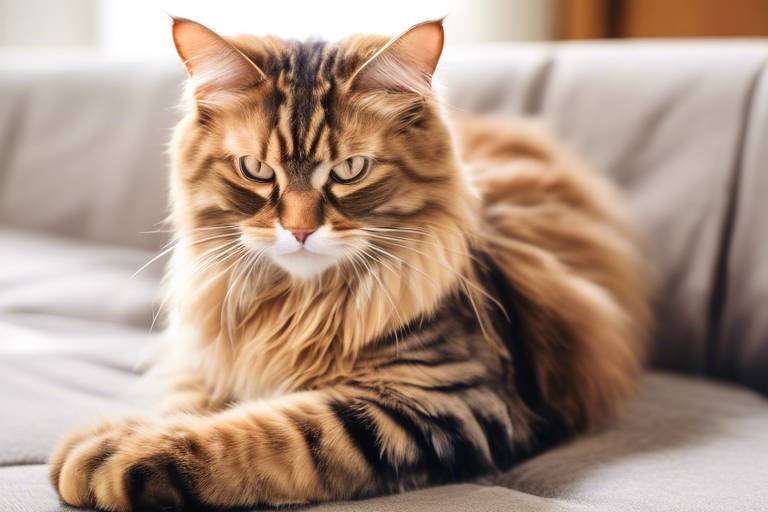The Traits of the Akita - Loyalty and Strength
The Akita breed is a magnificent testament to the qualities of loyalty and strength. These dogs are not just pets; they are a part of the family, embodying a spirit of devotion that is hard to match. If you’ve ever seen an Akita in action, you know that their presence commands respect and admiration. They are the kind of dogs that will stand by your side through thick and thin, offering companionship that is both unwavering and profound. In this article, we will explore the defining characteristics of the Akita breed, shedding light on what makes them such beloved companions and fierce protectors.
When we talk about the Akita, the first word that comes to mind is loyalty. These dogs are renowned for their unwavering commitment to their families. Imagine having a friend who is always there for you, no matter the circumstances—that’s what an Akita brings to the table. Their loyalty manifests in various ways: from following you around the house to being overly protective of your space. This bond is not just a simple attachment; it’s a deep emotional connection that grows stronger over time. Akitas can sense your feelings, and they often respond with a comforting presence when you’re feeling down or stressed.
The Akita's physical prowess is nothing short of impressive. With a muscular build and a commanding presence, these dogs are not just about looks; they possess incredible endurance and strength. This combination makes them exceptional working dogs and protectors. Whether it’s running alongside you during a jog or standing guard at your home, Akitas are always ready for action. Their powerful legs and sturdy frame allow them to navigate various terrains effortlessly, making them well-suited for outdoor adventures. You can think of them as the athletes of the dog world—always eager to showcase their skills.
To truly appreciate the Akita, it's essential to understand their rich history. Originating from Japan, these dogs were bred for hunting and guarding. The Akita has always held a special place in Japanese culture, symbolizing loyalty and fidelity. This historical significance provides insight into their loyal nature and the strong bonds they form with their owners. In fact, the story of Hachiko, an Akita who waited for his owner at a train station for years after his passing, is a poignant reminder of their unwavering loyalty.
In Japan, the Akita is celebrated not just as a breed but as a symbol of loyalty and fidelity. They are often featured in art, literature, and folklore, representing the deep emotional connections that can exist between humans and dogs. The Akita's image can be found in various forms, from traditional paintings to modern sculptures, each capturing their majestic presence and loyal spirit. This cultural significance adds another layer to their identity, making them more than just pets; they are a part of a rich heritage.
Today, Akitas serve various roles beyond companionship. They are increasingly recognized for their abilities as therapy dogs, providing comfort and support to those in need. Their gentle nature makes them suitable for working in hospitals and care facilities. Additionally, Akitas are often involved in search and rescue operations, using their keen sense of smell and intelligence to locate missing persons. As family protectors, they are vigilant and alert, making them excellent watchdogs. The versatility of the Akita is truly remarkable, showcasing their adaptability in various roles.
The temperament of an Akita is complex and multifaceted. While they are known for their protective instincts, they can also be quite aloof with strangers. This makes early socialization crucial. It’s essential to expose them to different environments, people, and other animals from a young age to foster a well-rounded personality. Think of it as giving them a toolkit for life, helping them navigate various social situations with confidence and ease. A well-socialized Akita is not just a loyal companion; they are also a friendly and approachable member of the family.
Training an Akita requires a unique blend of patience and consistency. These dogs are intelligent, but they can also be quite stubborn. It’s like trying to convince a teenager to do their homework—sometimes, it takes a little extra effort! Effective training techniques should harness their intelligence while promoting good behavior and obedience. Establishing clear boundaries and using positive reinforcement can go a long way in shaping their behavior.
While Akitas are highly intelligent, their stubborn streak can pose challenges during training. Owners often find themselves facing issues such as refusal to obey commands or selective hearing. To overcome these challenges, it’s important to remain calm and persistent. Consider using engaging training methods that keep your Akita interested, turning the learning process into a fun game rather than a chore.
Using positive reinforcement is crucial in training Akitas. This approach not only encourages desired behaviors but also strengthens the bond between dog and owner. Rewarding your Akita with treats, praise, or playtime when they follow commands can create a positive feedback loop. It’s like giving them a high five for a job well done! Over time, they will associate good behavior with positive outcomes, making them more likely to repeat those behaviors.
- What is the average lifespan of an Akita? The average lifespan of an Akita is around 10 to 15 years.
- Are Akitas good with children? Yes, Akitas can be good with children if properly socialized from a young age.
- Do Akitas require a lot of exercise? Yes, Akitas need regular exercise to stay healthy and happy.
- Are Akitas easy to train? They can be trained, but their stubbornness may require extra patience.
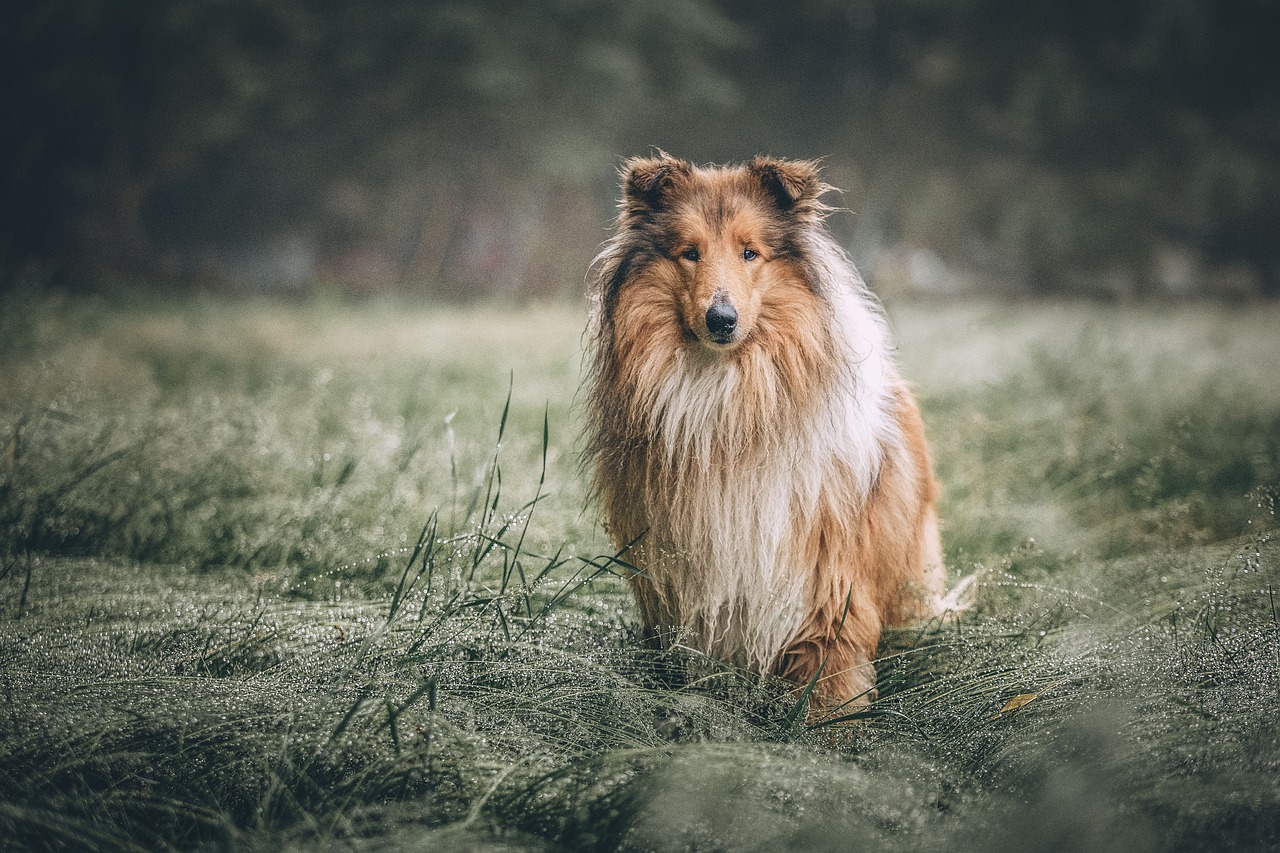
Loyalty: The Heart of the Akita
The Akita breed is often celebrated for its extraordinary loyalty, a trait that runs deep in their genetic makeup. When you bring an Akita into your home, you're not just getting a pet; you're welcoming a devoted companion who will stand by your side through thick and thin. This loyalty is not simply a characteristic; it is the very essence of what makes the Akita a beloved member of the family. Imagine a steadfast guardian who is always ready to protect you and your loved ones—this is the Akita in a nutshell.
Akitas are known to form incredibly strong bonds with their owners. They thrive on affection and companionship, often becoming deeply attached to their human families. This bond manifests in various ways, from their protective instincts to their desire to be near you at all times. Have you ever noticed how your Akita seems to follow you around the house? This behavior is a testament to their loyalty, as they want to be part of every moment of your life.
Moreover, the loyalty of an Akita goes beyond mere companionship. They possess a natural instinct to protect their home and family. This protective nature can be traced back to their history as hunting dogs in Japan, where they were bred to guard and defend. An Akita will not hesitate to stand between you and any perceived threat, showcasing their unwavering commitment to your safety. This fierce loyalty can be both a blessing and a challenge, as it requires responsible ownership and proper training.
In the world of dogs, the Akita stands out not just for its loyalty but also for its unique way of expressing it. They may not be the most overtly affectionate breed, but their loyalty is profound and unwavering. For instance, an Akita might not jump into your lap or shower you with kisses, but they will always be there, watching over you with a vigilant gaze. This quiet strength and presence create a sense of security that is hard to match.
To truly appreciate the loyalty of an Akita, it’s essential to understand the importance of socialization and training. Early exposure to various environments, people, and other animals is crucial in nurturing their loyalty in a well-rounded manner. An Akita that has been properly socialized will not only be loyal to its family but also learn to be accepting of new experiences, making them a joy to have around.
In conclusion, the loyalty of the Akita is not just a trait; it is a way of life. Their devotion to their families is unmatched, making them not only excellent companions but also reliable protectors. When you choose to share your life with an Akita, you are not just gaining a pet; you are gaining a loyal friend who will stand by you through all of life's adventures.
- What makes Akitas so loyal? Akitas are bred for loyalty and protection, forming strong attachments to their families.
- How can I strengthen my bond with my Akita? Spend quality time together, engage in training, and provide plenty of socialization opportunities.
- Are Akitas good with children? Yes, Akitas can be great with children when properly socialized, but supervision is always recommended.
- Do Akitas require a lot of exercise? Yes, they are active dogs and need regular exercise to stay healthy and happy.
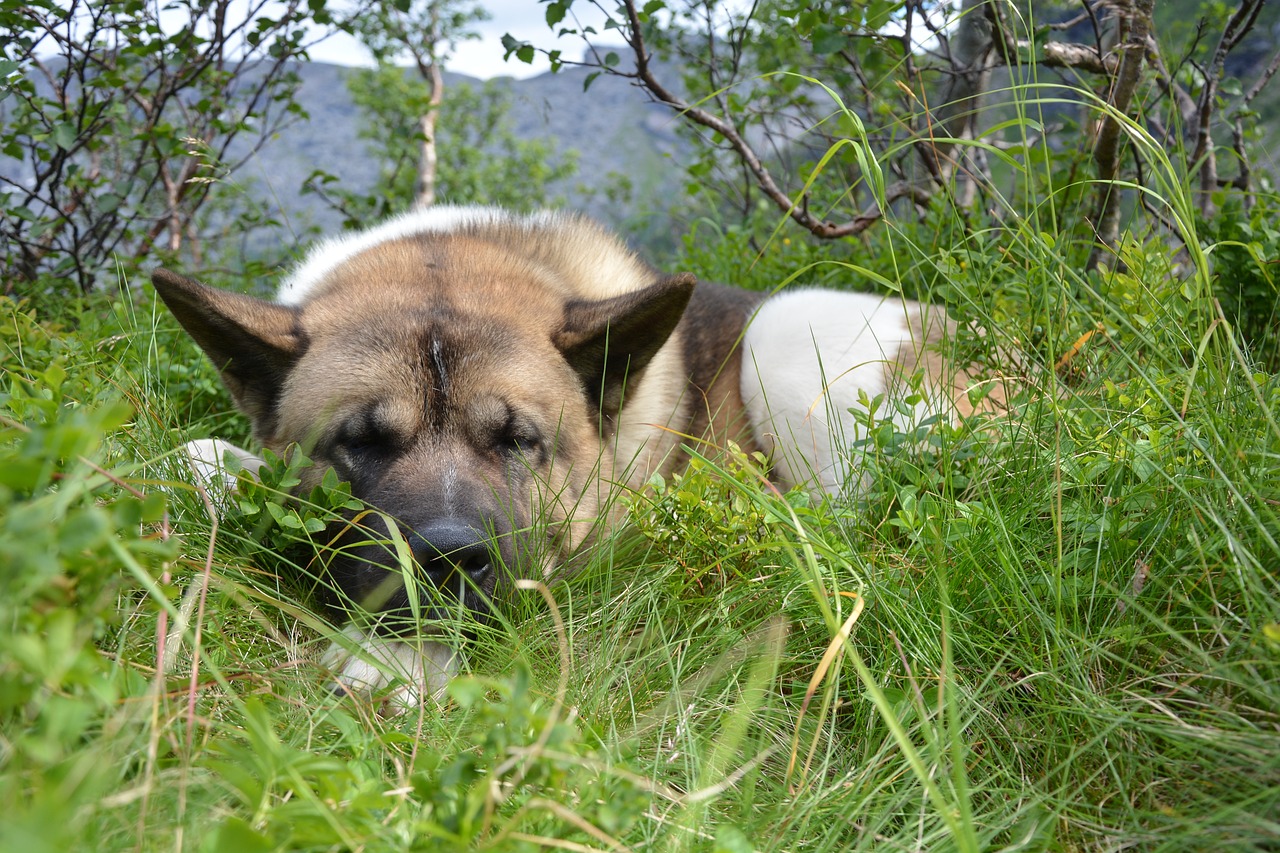
Physical Strength and Stamina
The Akita is not just a pretty face; this breed is a powerhouse of physical strength and stamina. With a muscular build that exudes confidence and agility, Akitas are designed for endurance. Imagine a lion prowling through the savannah—strong, proud, and ready to take on the world. That's the essence of an Akita. Their sturdy frame and powerful legs allow them to engage in various activities, from running to hiking, making them perfect companions for active families.
One of the most impressive aspects of the Akita's physicality is their endurance. These dogs can keep up with you on long walks or jogs, showing remarkable stamina that makes them ideal for outdoor adventures. Their strength is not just for show; it's a testament to their history as working dogs. Originally bred in Japan for hunting and guarding, Akitas possess an innate ability to perform demanding tasks, showcasing their resilience and tenacity.
To give you a clearer picture of their physical capabilities, let's take a look at some key characteristics:
| Characteristic | Description |
|---|---|
| Height | Typically ranges from 24 to 28 inches at the shoulder. |
| Weight | Generally weighs between 70 to 130 pounds. |
| Muscle Composition | Strong, well-defined muscles that contribute to their agility. |
| Endurance | Can sustain physical activity for extended periods. |
In addition to their physical prowess, Akitas are known for their loyalty and protective instincts, which further enhance their role as guardians. Their strength can be a double-edged sword; while they are affectionate with their families, they can also be wary of strangers, making them excellent watchdogs. This combination of loyalty and strength makes them not just pets but true family protectors.
Moreover, regular exercise is essential to keep an Akita healthy and happy. Engaging them in activities like agility training or obedience classes can help channel their energy positively and strengthen the bond between owner and dog. Think of it as a workout session for both of you; while you get fit, your Akita gets to showcase its natural abilities!
In summary, the Akita's physical strength and stamina are not merely traits but integral parts of their identity. They embody the spirit of a loyal companion and a formidable protector, making them a beloved choice for many dog lovers. So, if you're considering adding an Akita to your family, be prepared for an adventure filled with strength, loyalty, and a whole lot of love!
Historical Significance of the Akita
The Akita breed carries a rich tapestry of history that dates back to ancient Japan, where they were initially bred for hunting large game such as bears, boars, and deer. This remarkable lineage not only highlights their physical prowess but also underscores their importance in Japanese society. The Akita's journey from a hunting dog to a symbol of loyalty and fidelity is a testament to their enduring spirit and connection to human families.
In the early 17th century, the Akita was revered as the companion of Japanese nobility. They were often given as gifts to show respect and admiration, which further solidified their status in the cultural hierarchy. The breed's name itself is derived from the Akita Prefecture in northern Japan, where they were primarily developed. Over time, these dogs became associated with the samurai class, embodying the virtues of bravery and loyalty that were essential to the warrior ethos.
One of the most famous stories illustrating the Akita's loyalty is that of Hachiko, an Akita who waited for his deceased owner at a train station every day for nearly ten years. This touching tale has transcended generations, inspiring books, movies, and even a statue in Tokyo’s Shibuya Station, symbolizing the unbreakable bond between a dog and its owner. Hachiko's story has become a cultural icon, representing the unwavering loyalty that Akitas are known for.
Moreover, the Akita's historical significance extends beyond companionship. During World War II, many Akitas were sadly abandoned or killed, leading to a decline in their population. However, dedicated breeders worked tirelessly to revive the breed, ensuring that the Akita's legacy would endure for future generations. Today, the Akita is not only a beloved pet but also a symbol of resilience, loyalty, and strength in the face of adversity.
In summary, the Akita's historical significance is deeply intertwined with its identity as a loyal companion and protector. From their origins as hunting dogs to their revered status in Japanese culture, Akitas have left an indelible mark on the hearts of those who have had the privilege to know them. Their story is one of loyalty, courage, and an unbreakable bond with humans, making them truly exceptional companions.
Akitas in Japanese Culture
The Akita breed holds a special place in Japanese culture, symbolizing loyalty and fidelity. This majestic dog is not just a pet; it embodies the spirit of devotion that resonates deeply within the Japanese ethos. The story of Hachiko, an Akita known for his unwavering loyalty to his deceased owner, has become a cultural touchstone that highlights the breed's intrinsic qualities. Hachiko’s tale, which has been immortalized in films and literature, serves as a poignant reminder of the bonds that can exist between humans and their canine companions.
In Japan, Akitas are often associated with good fortune and protection. Families gift Akita figurines, especially during the New Year, as they are believed to bring blessings and prosperity. These figurines, often crafted from various materials, are not merely decorative; they represent a wish for the loyalty and strength that the Akita embodies. The act of gifting an Akita statue is akin to offering a guardian spirit to watch over the family, reinforcing the breed's status as a protector.
Moreover, Akitas have a presence in traditional Japanese art and literature. They appear in various forms, from paintings to poetry, often depicted in serene landscapes or alongside noble figures. The depiction of Akitas in art serves to elevate their status, showcasing their beauty and grace. In many ways, Akitas are seen as a reflection of the virtues that Japanese culture holds dear: strength, loyalty, and honor.
In contemporary Japan, Akitas continue to be celebrated through festivals and events that honor their legacy. These gatherings often feature dog shows, where the beauty and prowess of Akitas are on full display, attracting enthusiasts and families alike. Such events not only celebrate the breed but also foster a sense of community among Akita lovers, reinforcing the idea that these dogs are more than just pets; they are cherished members of the family.
As we delve deeper into the cultural significance of Akitas, it becomes clear that they are woven into the very fabric of Japanese society. Their representation in folklore, art, and daily life underlines their importance as symbols of loyalty and strength, making them not just companions but also cultural icons.
Modern Roles of Akitas
The role of the Akita has evolved significantly from its origins as a hunting dog in Japan to a versatile companion in modern society. Today, these majestic canines are not just pets; they are multi-talented partners who excel in various fields. Their unwavering loyalty and strong protective instincts make them ideal candidates for roles that require both affection and vigilance.
One of the most notable roles Akitas play today is that of therapy dogs. Their calm demeanor and innate ability to connect with humans have made them invaluable in therapeutic settings. Whether it's visiting hospitals, schools, or nursing homes, Akitas can provide comfort and emotional support to those in need. Their presence alone can lift spirits and create a sense of peace, showcasing their empathetic nature.
In addition to therapy work, Akitas are also making a name for themselves in the realm of search and rescue operations. Their impressive sense of smell, combined with their strength and stamina, allows them to navigate challenging terrains and locate missing persons. Imagine a scenario where a hiker gets lost in the woods; an Akita’s keen instincts and determination can be the difference between life and death. This role not only highlights their physical abilities but also their dedication to serving humanity.
Furthermore, Akitas are often seen as family protectors. Their natural guarding instincts make them vigilant watchdogs. They are known to be suspicious of strangers, which adds an extra layer of security to households. However, it’s essential for owners to balance this protective nature with proper socialization. When trained correctly, an Akita can distinguish between a friend and a foe, making them both a loving family member and a reliable protector.
Moreover, the versatility of the Akita allows them to participate in various canine sports and activities. From agility courses to obedience competitions, these dogs thrive on challenges that engage their minds and bodies. Their intelligence and athleticism make them suitable for a range of activities, further enriching the bond they share with their owners.
In conclusion, the modern roles of Akitas extend far beyond mere companionship. They are therapy dogs, search and rescue heroes, family protectors, and athletic competitors. This breed’s adaptability and profound loyalty continue to endear them to families and communities alike. As we witness their evolving roles, it’s clear that Akitas are not just dogs; they are trusted partners in various aspects of life, embodying the essence of loyalty and strength that they are so famously known for.
- What makes Akitas good therapy dogs? Akitas have a calm demeanor and a strong emotional connection with humans, making them excellent in therapeutic settings.
- Can Akitas be trained for search and rescue? Yes, their strong sense of smell and stamina make them suitable for search and rescue roles.
- How do I socialize my Akita? Early and consistent socialization with various people, environments, and other animals is crucial for a well-rounded Akita.
- Are Akitas good with children? With proper training and socialization, Akitas can be great family pets and protectors of children.
Temperament and Socialization
The temperament of an Akita is as complex as it is fascinating. Known for their strong-willed nature, Akitas are not just any dog; they are a breed that embodies a mix of independence and loyalty. This duality can sometimes leave owners scratching their heads, wondering how to best connect with their furry friend. Akitas are fiercely protective of their families, often acting as guardians, which makes them exceptional watchdogs. However, this protective instinct can lead to aloofness with strangers, making early socialization absolutely crucial.
Imagine an Akita as a loyal knight, always ready to defend its castle. But just like any knight, they need to learn the lay of the land. Early exposure to various people, environments, and other animals can help an Akita become a well-adjusted adult dog. Without this socialization, you might end up with a dog that is overly cautious or even aggressive towards unfamiliar faces. Think of it as teaching your knight the difference between a friend and a foe.
Socialization should begin as early as possible, ideally when the Akita is a puppy. This can include visits to parks, introducing them to different sounds, and allowing them to meet various people and pets. A well-socialized Akita is not only more comfortable in diverse situations but also tends to be more confident and relaxed. It’s like giving them a toolkit for navigating the world, making them less anxious and more adaptable.
Moreover, Akitas thrive on routine and structure, which means that consistent training and socialization practices will yield the best results. Engaging them in activities that challenge their minds and bodies can also help curb any undesirable behaviors that may arise from boredom or lack of stimulation. Just like us, dogs need a purpose! Whether it’s a game of fetch or a structured obedience class, keeping an Akita engaged is key to a harmonious household.
In summary, understanding the temperament of an Akita is essential for any prospective owner. Their protective nature, combined with their need for socialization, means that they require a dedicated owner who is willing to invest time and effort into their upbringing. With the right approach, your Akita can grow into a well-rounded companion, ready to take on the world by your side.
- What is the best age to start socializing my Akita?
It's best to start socializing your Akita as early as 8 weeks old. The earlier you introduce them to different people, pets, and environments, the better adjusted they will be. - Are Akitas good with children?
Akitas can be great with children, especially if they are raised with them. However, supervision is crucial, as their protective instincts can sometimes lead to guarding behaviors. - How do I train an Akita to be less aloof with strangers?
Positive reinforcement techniques, such as treats and praise, can help. Gradually exposing your Akita to new people in a controlled manner can also encourage more friendly behavior. - Can Akitas be trained to get along with other pets?
Yes, with early socialization and training, Akitas can learn to coexist peacefully with other pets. However, it requires patience and consistent effort from the owner.
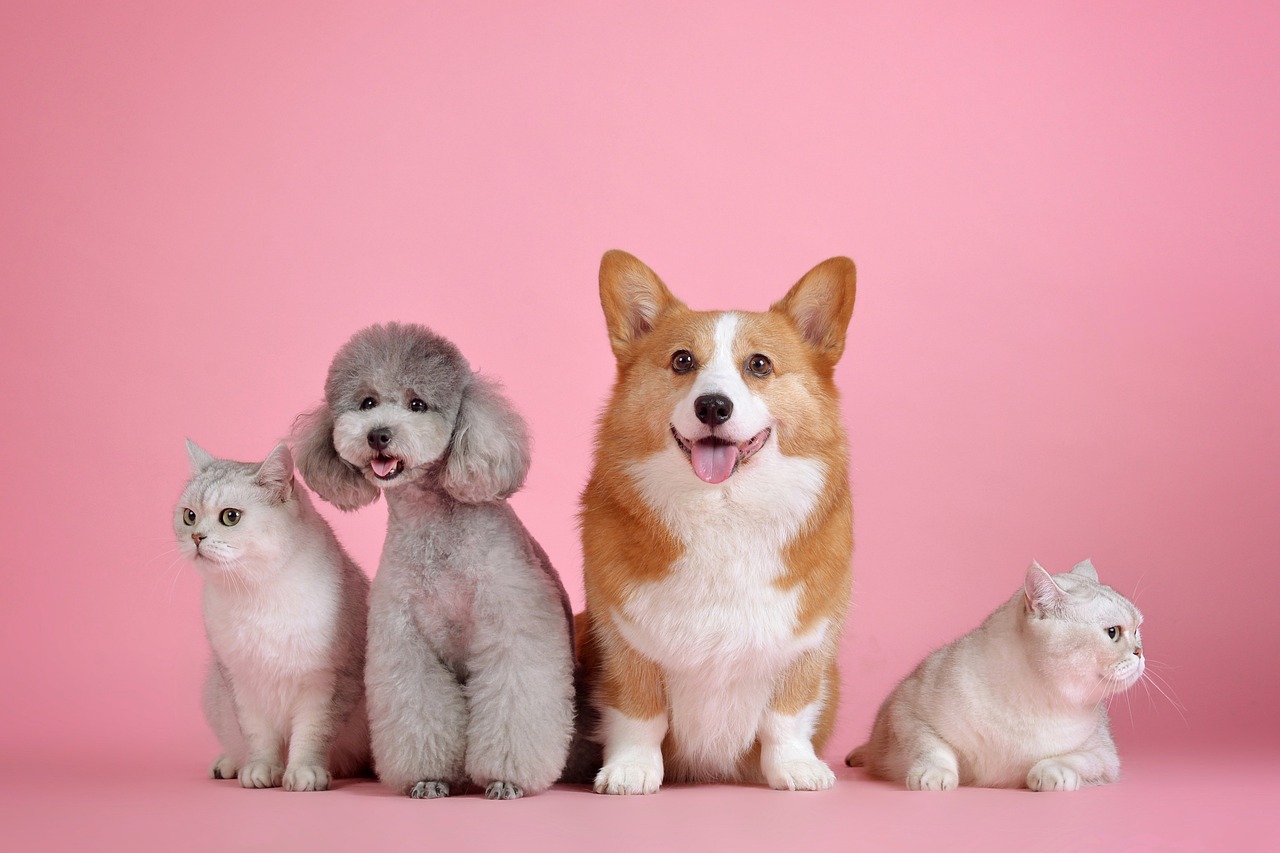
Training an Akita
Training an Akita can be a rewarding yet challenging experience. These magnificent dogs are not only known for their loyalty and strength but also for their intelligence. However, this intelligence can sometimes translate into a stubborn streak. Therefore, it’s essential to approach training with a strategy that combines patience, consistency, and a touch of creativity. Imagine trying to teach a child who is both brilliant and a bit rebellious; you need to engage them in a way that captures their interest while setting clear boundaries.
One of the first things to understand about Akitas is that they thrive on structure. Establishing a routine helps them feel secure and understand what is expected of them. This breed responds best to a training regimen that is consistent and predictable. For instance, setting specific times for feeding, walks, and training sessions will not only help in housebreaking but also in creating a well-disciplined dog. Think of it like a dance; if both partners know the steps, the performance will be seamless.
When it comes to training methods, positive reinforcement is the gold standard. Akitas respond exceptionally well to rewards such as treats, praise, or playtime. This technique not only encourages desired behaviors but also strengthens the bond between you and your furry friend. For example, when your Akita sits on command, rewarding them with a treat or a hearty “Good Boy!” can significantly boost their motivation. It's crucial to remember that harsh training methods can lead to fear and aggression, which is the opposite of what you want.
While training, it's also vital to incorporate socialization. Akitas can be aloof with strangers, so exposing them to different environments, people, and other pets will help them develop a well-rounded personality. Think of socialization as a toolbox; the more tools you add, the better equipped your Akita will be to handle various situations. Regular visits to the dog park or inviting friends over can be excellent opportunities for socialization.
However, training an Akita isn't without its challenges. Common issues include their independent nature and occasional stubbornness. For instance, if your Akita decides that they don’t want to sit, no amount of coaxing might change their mind. In such cases, it’s essential to remain calm and not show frustration. Instead, try to redirect their focus or use a higher-value treat to entice them. Remember, the goal is to make training a fun and positive experience for both of you.
| Training Techniques | Description |
|---|---|
| Positive Reinforcement | Using treats or praise to encourage good behavior. |
| Consistency | Establishing a routine and sticking to it. |
| Socialization | Exposing your Akita to various environments and people. |
| Patience | Remaining calm and understanding during training challenges. |
In conclusion, training an Akita is a journey filled with ups and downs, much like a roller coaster ride. Embrace the adventure, celebrate the small victories, and remember that every moment spent training is an investment in a lifetime of companionship. With the right approach, your Akita will not only learn commands but also become a well-behaved member of your family.
- How long does it take to train an Akita? Training duration varies, but consistency and daily practice can yield results in a few weeks.
- Can Akitas be trained off-leash? With proper training and socialization, some Akitas can be trained to be off-leash, but caution is advised.
- What is the best age to start training an Akita? Start training as early as eight weeks old to instill good habits.
- Are Akitas good with children? Akitas can be good with children, but supervision is essential, especially during playtime.
Common Training Challenges
Training an Akita can be a rewarding yet challenging experience. These magnificent dogs are known for their intelligence and strong-willed nature, which can sometimes lead to a bit of a standoff between them and their owners. One of the most common challenges faced by Akita owners is their stubbornness. This breed has a mind of its own, and while they are quick learners, they may choose to ignore commands if they don’t see the point in following them. It’s like trying to convince a teenager to clean their room—sometimes, they just don’t want to do it!
Another challenge is their protective instincts. Akitas are naturally wary of strangers, which can lead to issues when it comes to socialization. If not properly introduced to new people and environments during their formative months, they may develop fear or aggression towards unfamiliar faces. This protective nature, while admirable, can make training a bit tricky, as it requires a careful balance of desensitization and reinforcement of positive behaviors.
Additionally, Akitas can be quite independent, which means they might not always respond to commands as eagerly as other breeds. This independence can be a double-edged sword; it’s what makes them such strong and capable dogs, but it can also mean that they might decide that lying on the couch is far more appealing than performing tricks or obeying commands. Owners often find themselves in a tug-of-war, trying to engage their Akita while also respecting their need for autonomy.
To tackle these challenges, consistency is key. Establishing a routine and sticking to it can help your Akita understand what is expected of them. Using clear commands and being patient during training sessions can also make a significant difference. Here are some strategies to consider:
- Set Clear Boundaries: Be consistent with rules and commands to avoid confusion.
- Short Training Sessions: Keep sessions brief but frequent to maintain your Akita’s interest.
- Socialization: Expose your Akita to various environments, people, and other animals early on.
While these challenges can be daunting, they are not insurmountable. With the right approach, your Akita can become a well-behaved and loyal companion. Remember, training is not just about obedience; it’s also about building a strong bond with your furry friend. So, embrace the journey, and don’t be afraid to seek help from professional trainers if you find yourself struggling. After all, every great relationship requires a little work!
1. How long does it take to train an Akita?
Training an Akita can vary based on individual temperament and previous experiences. Generally, expect to see noticeable progress within a few weeks, but consistent training should continue throughout their life.
2. Are Akitas good with children?
Yes, Akitas can be great with children, especially if they are raised together. However, early socialization is crucial to ensure they are comfortable with kids and understand boundaries.
3. What is the best way to socialize an Akita?
The best way to socialize an Akita is to expose them to a variety of environments, people, and other animals from a young age. Positive experiences will help them become more adaptable and less wary of new situations.
4. Can Akitas be trained to be off-leash?
While it is possible to train an Akita to be off-leash, it requires a high level of obedience and trust. Consistent training and a strong recall command are essential before attempting off-leash adventures.
Positive Reinforcement Techniques
Training an Akita can be a rewarding yet challenging journey. One of the most effective methods for teaching your furry friend is through positive reinforcement. This technique involves rewarding your dog for desired behaviors, making them more likely to repeat those behaviors in the future. Imagine this: every time your Akita sits on command, you shower them with praise, treats, or a favorite toy. This not only helps them learn but also strengthens the bond between you and your pet.
Positive reinforcement works on the principle of operant conditioning, where behaviors are shaped by consequences. For an Akita, who is both intelligent and strong-willed, this approach can yield fantastic results. Instead of using harsh corrections, which can lead to fear or aggression, focus on the good. For instance, if your Akita walks nicely on a leash without pulling, reward them immediately with a treat or affectionate words. This immediate feedback helps them associate good behavior with positive outcomes.
It's essential to be consistent with your rewards. If you reward your Akita for sitting one day but ignore the behavior the next, they may become confused about what you expect from them. Consistency creates a clear understanding of what behaviors are desirable. Additionally, make sure to vary your rewards. While treats are great, sometimes a game of fetch or a belly rub can be just as motivating! This variety keeps training sessions exciting and engaging for your Akita.
Another critical aspect of positive reinforcement is timing. The reward must come right after the desired behavior. For example, if your Akita lies down when asked, give them a treat immediately. This connection helps them understand exactly what they did right. If you wait too long, they might not associate the treat with the action, leading to confusion.
Incorporating play into training is also beneficial. Akitas are playful by nature, and using games as a reward can make training feel less like a chore. For instance, you can use a toy to encourage your Akita to come when called. When they respond correctly, engage them in a fun game. This not only reinforces the command but also makes training a fun experience for both of you.
Lastly, remember that patience is key. Some Akitas may take longer to learn certain commands than others. Celebrate small victories and don't be discouraged by setbacks. Every dog is unique, and your Akita's journey will be their own. With time, love, and consistent positive reinforcement, you will cultivate a well-behaved and happy companion.
- What is positive reinforcement? Positive reinforcement is a training method that rewards desired behaviors to encourage them in the future.
- How do I choose the right rewards for my Akita? The best rewards are those that your dog finds motivating, such as treats, toys, or praise.
- Can I use positive reinforcement for bad behaviors? While you can't reward bad behavior, you can redirect it and reward the desired behavior instead.
- How long should training sessions be? Keep sessions short and engaging, ideally around 5-10 minutes, to maintain your Akita's focus.
Frequently Asked Questions
- What makes Akitas such loyal companions?
Akitas are known for their deep emotional bonds with their families. Their loyalty stems from their history as working dogs, where they were bred to protect and serve. This loyalty manifests in their protective instincts and desire to be close to their owners, making them not just pets, but true family members.
- How strong are Akitas physically?
Akitas are incredibly strong dogs with a muscular build and impressive stamina. They were originally bred for hunting and guarding, which means they have the physical prowess to perform demanding tasks. Their strength is not just about size; it's also about endurance, allowing them to be active and engaged in various activities.
- What is the historical significance of the Akita breed?
The Akita breed has a rich history that dates back to Japan, where they were revered for their loyalty and courage. They symbolize fidelity and are often associated with the famous story of Hachiko, a dog known for his unwavering loyalty to his owner. Understanding their history gives insight into their temperament and the strong bonds they form with humans.
- How are Akitas represented in Japanese culture?
In Japanese culture, Akitas are celebrated as symbols of loyalty and protection. They appear in various forms of art, literature, and folklore, often embodying the virtues of fidelity and devotion. This cultural significance enhances their status as beloved companions and highlights their importance in Japanese heritage.
- What roles do Akitas play in modern society?
Today, Akitas serve various roles beyond companionship. They are utilized as therapy dogs, search and rescue canines, and family protectors. Their intelligence and loyalty make them well-suited for these roles, allowing them to contribute positively to the lives of many people.
- How should I socialize my Akita?
Socialization is crucial for Akitas to develop a well-rounded personality. Early exposure to different people, environments, and other animals can help reduce their natural aloofness with strangers. It's essential to start socialization as a puppy and continue it throughout their life to ensure they feel comfortable and confident in various situations.
- What are some common training challenges with Akitas?
While Akitas are intelligent, they can also be quite stubborn. This can lead to challenges during training, such as resistance to commands or distractions. However, with patience, consistency, and the right techniques, these challenges can be overcome, allowing for successful training experiences.
- What are effective training methods for Akitas?
Positive reinforcement techniques are the most effective way to train Akitas. Using treats, praise, and play as rewards encourages desired behaviors while strengthening the bond between the dog and owner. It's important to keep training sessions fun and engaging to maintain their interest and motivation.


